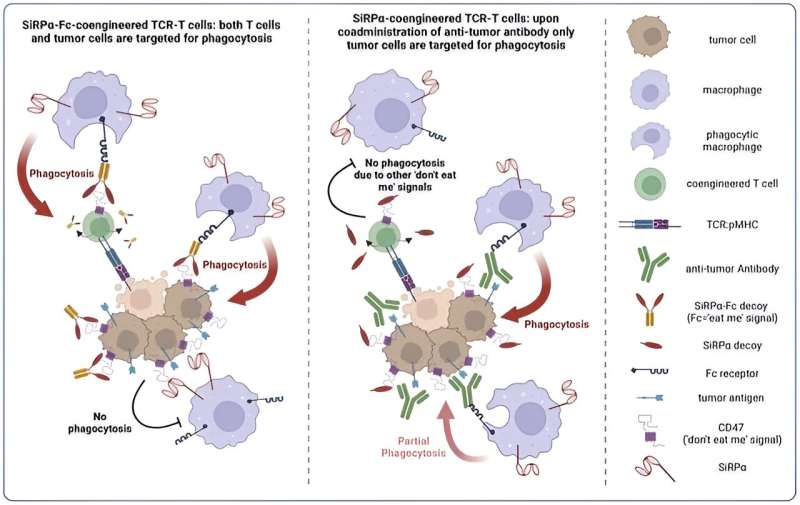This article has been reviewed according to Science X's editorial process and policies. Editors have highlighted the following attributes while ensuring the content's credibility:
fact-checked
peer-reviewed publication
trusted source
proofread
Two-pronged attack strategy boosts immunotherapy in preclinical studies

A novel immunotherapy approach developed by Ludwig Cancer Research scientists employs a two-pronged attack against solid tumors to boost the immune system's ability to target and eliminate cancer cells.
The research focuses on an immunotherapy called adoptive cell transfer (ACT), which involves extracting T cells from a patient, enhancing their ability to fight cancer, expanding them in culture and reinfusing them into the patient's body.
"While T cell therapies have shown tremendous success in treating certain blood cancers, solid tumors present a more complex challenge due to immune-suppressive mechanisms at play in the tumor microenvironment," said Ludwig Lausanne's Melita Irving, who led the study. "T cells alone may not be sufficient, which is why we're exploring ways to boost their effectiveness by integrating other immune-enhancing strategies."
In the study, detailed in the Journal of Clinical Investigation, Irving and her team modified T cells to secrete CV1, a high-affinity version of the human signal regulatory protein alpha (SiRPα).
SiRPα normally interacts with CD47, a protein found on the surface of healthy cells that transmits a "don't eat me" signal to prevent macrophages from gobbling them up. However, many cancer cells exploit this system by overexpressing CD47 to avoid being eaten, or "phagocytized."
"The innate immune system, especially macrophages—which can consume tumor cells—is crucial to our immune defenses against cancer," Irving explained. (T cells belong to a separate arm of the immune system known as the adaptive immune system.)
The previously developed CV1 decoy utilized by Irving's team binds CD47 with high affinity, effectively silencing the "don't eat me" signal. This, it was expected, would make the cancer cells more recognizable and susceptible to macrophage attack while they were simultaneously being targeted by the engineered T cells, which had also been co-engineered to express an affinity-optimized T cell receptor (TCR).
However, the team encountered an unexpected problem. The CV1 their T cells were engineered to secrete included an Fc tail, which is ordinarily found at the tail end of an antibody molecule and doubles as a tag that draws macrophage attack. Since that tag now coated the T cells secreting the engineered CV1, it invited a full-on macrophage assault on the therapeutic T cells, leading to their depletion in treated mice.
To correct this, Evangelos Stefanidis, first author of the study and a recent Ph.D. graduate from Irving's group, modified the T cells to express CV1 alone, without the Fc tail. This prevented the engineered T cells from being targeted by human macrophages.
Moreover, combining these CV1-producing T cells with cancer-targeting antibodies such as avelumab and cetuximab further improved the ability of macrophages to consume tumor cells. This was because these antibodies—which target the immune-suppressing PD-L1 molecule and the growth-promoting epidermal growth factor receptor (EGFR), respectively—possess active Fc tails that engage macrophages to attack the tumor cells specifically. The team also observed that treating mice with these antibodies favorably altered the tumor microenvironment to support immune attack.
"By removing the Fc tail, we could spare the T cells from human macrophages, and by combining the co-engineered T cells with clinical antibodies comprising an active Fc tail, we specifically augmented phagocytosis of the tumor cells by macrophages," Irving explained.
The findings could also help explain why clinical trials of the antibody drug magrolimab have faced significant challenges, including poor patient responses and infections. Like the CV1 decoy, magrolimab blocks the CD47 "don't eat me" signal on tumor cells to encourage their destruction by the immune system. But if—like the CV1 decoys with Fc tails—its blocking action is not targeted exclusively to cancer cells, it could provoke the destruction of healthy tissues.
"It is possible that magrolimab is also targeting immune cells, including T cells, for phagocytosis," Irving said. "Our combination treatment strategy helps direct phagocytosis specifically against tumor cells while sparing our engineered T cells. Our findings also highlight the complexities of cancer treatment and the importance of a nuanced approach to immunotherapy."
More information: Evangelos Stefanidis et al, Combining SiRPα decoy–coengineered T cells and antibodies augments macrophage-mediated phagocytosis of tumor cells, Journal of Clinical Investigation (2024). DOI: 10.1172/JCI161660



















